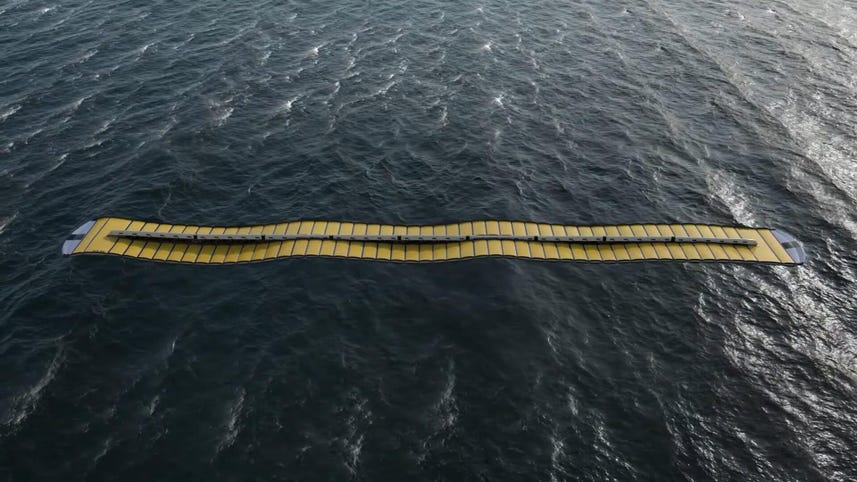
Speaker 1: This long yellow raft harnesses the power of the ocean to compete with fossil fuels. Meet the wave line magnet made by sea wave energy limited or swell for short. We spoke to the company's CO c e o to learn about how it works, the different needs it could serve, and what's next for this wave? Power tech. Let's dive in.
Speaker 2: We're not trying to compete with the other people in Wave Energy. We're not trying to compete either with wind and solar, which is already commercially mature. We're trying to compete with fossil fuels.
Speaker 1: [00:00:30] Fossil fuels accounted for 82% of the world's energy supply in 2022. So the folks at Swell are really aiming big. They've been developing their wave energy converter for over 10 years, a journey which has led them to this unique design and involved collaboration across generations. Starting with the man scene here, riding on the back of his invention.
Speaker 2: That's my dad actually. So <laugh>, that's the inventor. We are not a company that sits in an office and looks [00:01:00] at numbers and produces reports and publications and says, this is what our technology does. We sit on the system, we play with it, we understand it, we feel it. You know, just like when you are driving a car, you know, you turn the wheel and you feel how the wheel pushes back. You feel how things react to your inputs.
Speaker 1: Their years of testing in both wave pools and the open ocean have led them to the wave line magnet design, which has four main components.
Speaker 2: The first component, and well you could say the most important, is the spine that runs [00:01:30] down the center of the entire system. That is basically the component which holds everything together. It gives us a reference point to work around. Number two is the platforms which connect to the surface, to the WaveLight, what we usually call it. The third one are levers, so all they do is just connect the platforms to the spine. And then the final component is the power takeoff, which is the pumps.
Speaker 1: The pumps suck up seawater and pressurize it by using the seawater itself. The wave line magnet avoids any risk of ocean [00:02:00] contamination in the event of a leak, which you might get with other materials such as oil, the pressurized seawater as how the wave line magnet harnesses what Alex called the raw power of the wave, which can then be used for several different purposes.
Speaker 2: You can use this flow of seawater to create electricity, if you like, of course, and you can use that power to desalinate water on board. And other application is hydrogen, which is sort of a byproduct of, of the electricity, but then it can also [00:02:30] store the hydrogen within its body. The
Speaker 1: Fact that the wave line magnet attaches to the ocean's surface and moves with it minimizes the wear and tear and the need for maintenance. SW also says its wave energy converter can be made from recyclable materials and is open to working with sustainability advocates and environmental regulators to ensure the final design protects ocean ecosystems. Depending on how the wave line magnet is configured, it could someday end up as a hydrogen fuel power station for passing boats, [00:03:00] an energy lifeline to coastal communities, or a key source of freshwater via desalination. The amount of wave power one of these is able to harness, depends on how large it is and the size of waves in the operating area. On the larger end. These wave line magnets can be about 24 meters wide and 600 meters long. Alex says that a case study prepared for one of these larger units operating off the coast of Scotland, where waves were an average of three meters tall, estimated 140 gigawatt hours of energy harnessed [00:03:30] annually.
Speaker 2: You know, we're talking power station levels of production from a single system.
Speaker 1: The Wave line Magnet recently completed two rounds of testing and only has one more planned before it takes the next step towards commercialization.
Speaker 2: It's basically the last system, uh, that we're going to test before commercialization about our first, you know, commercially available product. This pilot will most likely be here in Cyprus. It's just gonna be down there in the seat. <laugh>.
Speaker 1: Alex says [00:04:00] that the first commercial product will likely be a smaller unit focused on desalination.
Speaker 2: Our first commercially available system will desalinate, depending on wave climber, between 10 to 50 tons of, uh, water per hour at a cost, which is about a third of the conventional methods.
Speaker 1: Well, is also in the process of developing strategic partnerships to help bring its products to market. As always, thanks so much for watching. I'm your host, Jesse Oral. See you next time with the fam.